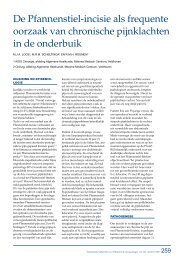Surgical management of chronic inguinal pain syndromes - Liespijn
Surgical management of chronic inguinal pain syndromes - Liespijn
Surgical management of chronic inguinal pain syndromes - Liespijn
Create successful ePaper yourself
Turn your PDF publications into a flip-book with our unique Google optimized e-Paper software.
pathway for the cremasteric reflex. The femoral branch innervates the skin <strong>of</strong> theanterior upper leg region. It should be stressed that anatomical variations in the <strong>inguinal</strong>course <strong>of</strong> all three <strong>inguinal</strong> nerves are exceedingly common 8 .Pain characteristics after <strong>inguinal</strong> hernia repair or Pfannenstiel incisionsThe pathogenesis <strong>of</strong> <strong>chronic</strong> <strong>pain</strong> after <strong>inguinal</strong> hernia repair in general has been scarcelyinvestigated. An early 1942 study reported on ‘genit<strong>of</strong>emoral causalgia’ following a herniaoperation 9 . In 1988 Lichtenstein published a review on causes and prevention <strong>of</strong> postherniorrhaphyneuralgia following mesh repair emphasizing the necessity <strong>of</strong> nerveidentification and preservation 10 . However, it took nearly twenty years before a classificationfor postherniorrhaphy groin <strong>pain</strong> <strong>syndromes</strong> was proposed 11 . It was suggestedthat <strong>pain</strong> <strong>syndromes</strong> should be classified as ‘neuropathic’ and ‘non-neuropathic’.Neuropathic <strong>pain</strong> is thought to be caused by neuroma formation due to damaged nervetissue or entrapment following compressive sutures or mesh material. Development<strong>of</strong> fibrosis over time may also lead to compression <strong>of</strong> neural structures. Neuropathic<strong>pain</strong> is characterized as sharp or stabbing and is situated in or around the <strong>inguinal</strong> scar.Neuropathic <strong>pain</strong> frequently radiates into its associated skin area. Physical examination<strong>of</strong>ten reveals neurophysiological abnormalities including hypoesthesia, hyperesthesiaor allodynia. On the other hand, non-neuropathic (‘nociceptive’) <strong>pain</strong> is due to damagedsurrounding structures such as periostal layers or musculotendinous tissues. Mechanicalpressure due to gradual mesh displacement or contraction is also implicated as a source<strong>of</strong> nociceptive <strong>pain</strong> 11 . Nociceptive <strong>pain</strong> is <strong>of</strong>ten described as aching or pulling in theFigure 1 Neuro-anatomy <strong>of</strong> the male <strong>inguinal</strong> region. Figure 2 The Pfannenstiel incision in relation to the iliohypogastric (A) and ilio<strong>inguinal</strong> (B) nerve 7 .10 Chapter 1Introduction, aims and outline 11





